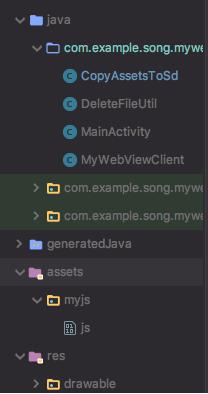前言
最近接到一个js文件缓存任务,即通过拦截我们webView的url,首先从文件加载js文件,文件里没有的话就去assets里面Copy过来。感觉这个工具类挺有用的,所以先发上来供大家参考。稍后有时间会把整个项目思路写出来。
项目代码
public class CopyAssetsToSd {
final ThreadPoolExecutor threadPoolExecutor = new ThreadPoolExecutor(1, 2, 1, TimeUnit.SECONDS,
new LinkedBlockingQueue<Runnable>(100));
private Context mContext;
/**
* assets的文件夹 js
*/
private String assetDir;
/**
* 目标文件夹
*/
private String dir;
public CopyAssetsToSd(Context context, String assetDir, String dir) {
mContext = context;
this.assetDir = assetDir;
this.dir = dir;
new MyAsyncTask().execute();
}
/**
* 监听复制完成
*/
public interface onCopyListener {
void success();
}
private onCopyListener mOnCopyListener;
public void setOnCopyListener(onCopyListener onCopyListener) {
this.mOnCopyListener = onCopyListener;
}
public void copyAssets(final String assetDir, final String dir) {
//下面是线程池的方法
threadPoolExecutor.execute(new Runnable() {
@Override
public void run() {
String[] files;
AssetManager assetManager = mContext.getResources().getAssets();
try {
// 获得Assets文件夹下指定文件夹一共有多少文件
files = assetManager.list(assetDir);
} catch (IOException e1) {
return;
}
final File mWorkingPath = new File(dir);
// 如果文件路径不存在
if (!mWorkingPath.exists()) {
mWorkingPath.mkdirs();
}
for (int i = 0; i < files.length; i++) {
int finalI = i;
try {
// 获得每个文件的名字
String fileName = files[finalI];
File outFile = new File(mWorkingPath + "/" + fileName);
// 判断文件是否存在
if (!outFile.exists()) {
outFile.createNewFile();
FileOutputStream out = new FileOutputStream(outFile);
InputStream in = null;
if (0 != assetDir.length())
in = assetManager.open(assetDir + "/" + fileName);
else
in = assetManager.open(fileName);
// Transfer bytes from in to out
byte[] buf = new byte[1024];
int len;
while ((len = in.read(buf)) > 0) {
out.write(buf, 0, len);
}
in.close();
out.close();
} else {
}
} catch (FileNotFoundException e) {
e.printStackTrace();
} catch (IOException e) {
e.printStackTrace();
}
}
}
});
//下面是线程的方法
// new Thread(new Runnable() {
// @Override
// public void run() {
// String[] files;
// AssetManager assetManager = mContext.getResources().getAssets();
// try {
// // 获得Assets一共有几多文件
// files = assetManager.list(assetDir);
// } catch (IOException e1) {
// return;
// }
// final File mWorkingPath = new File(dir);
// // 如果文件路径不存在
// if (!mWorkingPath.exists()) {
// mWorkingPath.mkdirs();
// }
//
// for (int i = 0; i < files.length; i++) {
// int finalI = i;
//
// try {
// // 获得每个文件的名字
// String fileName = files[finalI];
// File outFile = new File(mWorkingPath + "/" + fileName);
// // 判断文件是否存在
// if (!outFile.exists()) {
// outFile.createNewFile();
// FileOutputStream out = new FileOutputStream(outFile);
// InputStream in = null;
// if (0 != assetDir.length())
// in = assetManager.open(assetDir + "/" + fileName);
// else
// in = assetManager.open(fileName);
// // Transfer bytes from in to out
// byte[] buf = new byte[1024];
// int len;
// while ((len = in.read(buf)) > 0) {
// out.write(buf, 0, len);
// }
// in.close();
// out.close();
// } else {
//
//
// }
// } catch (FileNotFoundException e) {
// e.printStackTrace();
// } catch (IOException e) {
// e.printStackTrace();
// }
// }
//
// }
//
// }).start();
}
class MyAsyncTask extends AsyncTask<String, Void, Bitmap> {
//onPreExecute用于异步处理前的操作
@Override
protected void onPreExecute() {
super.onPreExecute();
}
//在doInBackground方法中进行异步任务的处理.
@Override
protected Bitmap doInBackground(String... params) {
copyAssets(assetDir, dir);
return null;
}
//onPostExecute用于UI的更新.此方法的参数为doInBackground方法返回的值.
@Override
protected void onPostExecute(Bitmap bitmap) {
super.onPostExecute(bitmap);
if (mOnCopyListener != null) {
//复制完成的监听
mOnCopyListener.success();
}
}
}
}参数说明

项目截图:

因为assets下面有很多隐藏文件,在查找的时候会很冗余。所以我们自建了一个文件夹myjs,所以我们的assetDir参数是myjs。
结语
由于最近比较忙,暂时先写这么多,项目过一段时间补上。
以上就是本文的全部内容,希望对大家的学习有所帮助,也希望大家多多支持亿速云。
亿速云「云服务器」,即开即用、新一代英特尔至强铂金CPU、三副本存储NVMe SSD云盘,价格低至29元/月。点击查看>>
免责声明:本站发布的内容(图片、视频和文字)以原创、转载和分享为主,文章观点不代表本网站立场,如果涉及侵权请联系站长邮箱:is@yisu.com进行举报,并提供相关证据,一经查实,将立刻删除涉嫌侵权内容。